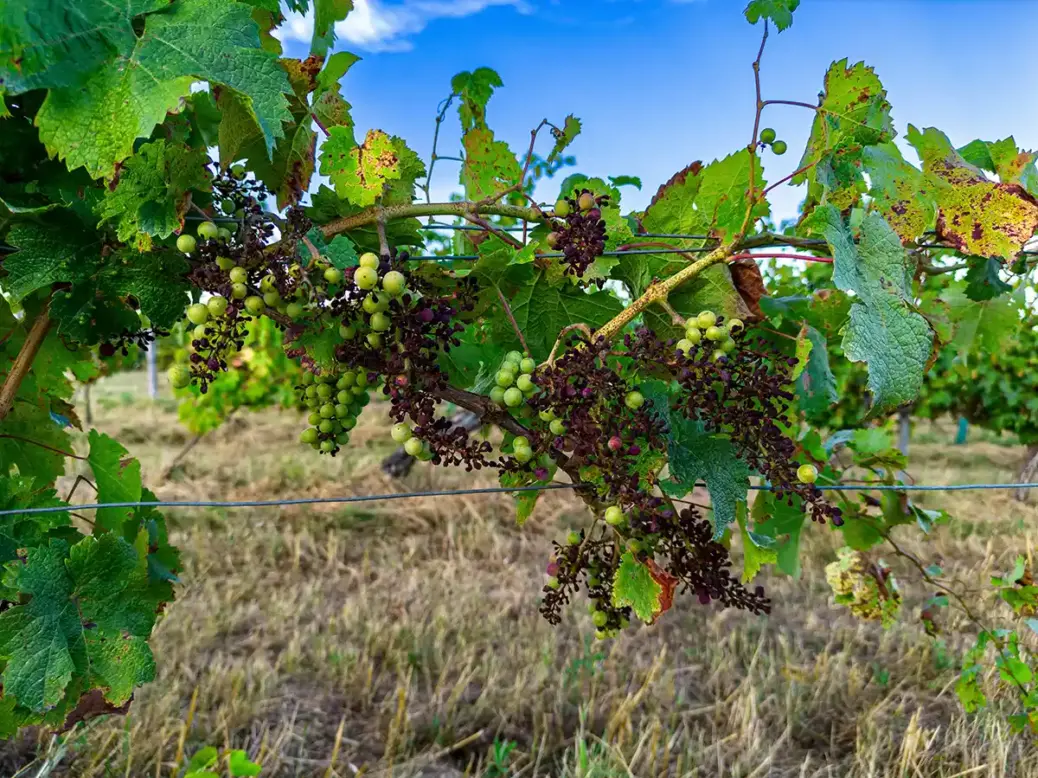
Mildew was a persistent threat for Bordeaux châteaux in 2023. But how much say did it have on the character and quality of the vintage, asks Simon Field MW in his latest blog from the 2023 en primeur tastings.
Shakespeare’s sorrows, we recall, came not as single spies but in battalions. In Bordeaux, of late, harvests seem to provoke something of a generalization, threatened therefore by spies rather than by the battalions. In 2017 it was frost, in 2022 the drought and so forth. In 2023 it has been the turn of mildew to take center stage. A very canny spy, downy mildew, and often, as is the nature of espionage, preparing the ground for future woe. The battalions are usually lurking in the wings.
Or not as the case may be. 2023 may well be remembered as the vintage of the haves versus the have nots. It was, as Antoine Mariau at Château Nénin has commented; “le millésime des riches,” because the cost required to counter the threat in terms of resource and labor was immense, but if one was able to meet such a cost then the damage would be minimal. Less than zero, some may argue, if it leads to more concentrated grapes. With mildew there is no escaping the effort required to keep it at bay; the copper solution, as Jean Jacques Bonnie at Malartic Lagravière reminds us, is a mere external application (he compares it somewhat disingenuously as a suntan lotion), so every times it rains it has to be reapplied. Extra time, more workers, more cost, and quite simply beyond the means of a large number of produces in badly hit areas such as Entre Deux Mers and Castillon Côtes de Bordeaux. Those with the means were spared, or at least their vines were spared, which is probably tantamount to the same thing. Olivier Bernard is bullish; 100 years ago, the amounts of copper employed were huge (hundreds of tons, it seems). Now, the recommended limit is 4 tons. “I will use more if I have to and I definitely had to in 2023,” he advises, adding that DRC does it, so why not DDC?! Why not indeed.
The mildew came as a result of a gradual build up of heat on and after budburst. Both 2018 and 2021 were affected, but less persistently and less dangerously. The temperatures rose gradually as spring advanced, with April and May one degree above average, and June, the cruelest month in this episode, a full three degrees above the norm. This was highly unusual and all the more so when allied to the persistent precipitation which resulted in near tropical conditions and a flurry of preventative activity. Pomerol got off reasonably lightly (such things are always localized over such an immense vineyard) but Juliette Couderc at L’Evangile is forthright in describing “une semaine de l’horreur” (a week of horror) which ran from June 19-24, and which dropped 70mm (2.75 inches) of rain with four consecutive rounds of treatment the result.
Decimation and the like
Those without resources simply lost a significant tranche of the crop and in such cases the hyperbolic newspaper articles describing “decimation” and the like, were not without justification. Even more prestigious (and ostensibly very wealthy) properties such as Smith Haut Lafite (run biodynamically) suffered, in their case with the loss of a significant percent of their Merlot, the varietal on the earlier cycle and therefore more vulnerable. Fabien Teitgen, the longstanding and highly successful Technical Director at Smith, shrugs, and says that in the face of nature’s whim he is but “an openminded peasant.” One may well only agree with the first half, at least, of such a description.
Mildew, even if kept at bay, can always return, as was the case in 2018. As it turned out, there was little recurrence in 2023 after the travails of June, but its incipient threat had a bearing on the approach to subsequent leaf-plucking (especially as the humid conditions encourage extravagant foliage) and green harvesting. All the more surprising then, to learn that the better-known appellations, those with the resources, were able to report yields which were generally hovering around the average or in some cases (St-Estèphe comes to mind) higher than usual. Neither quality nor quantity suffered here, a far cry from many labels bearing the more modest colours of AOC Bordeaux or Bordeaux Superieur, where overall yields were closer to 30 than 50 hl/ha. The commercial impact of such a shortfall can not be overstated.
Very different outcomes in 2023, then, and largely down to means rather than expertise. Once vanquished, the mildew, unlike, say, the heat stress of 2022, had minimal bearing on the personality of the vintage which followed. It served, however, to underline the caprice of nature and the need for vigilance. Writing this, at the end of April 2024, it is fair to say that Bordeaux has experienced plenty of contrasts; temperatures of 29°C (84°F) two weeks ago and then last week near-freezing nights and the very real dangers of frost revisited, with a battery of defences brought to bear to try to keep it at bay. One can never be too sure where the next spy may be coming from.
Bordeaux 2023 Field notes: Out of sorts?
Bordeaux 2023 Field notes: Château La Tour Figeac—La Chartreuse de St-Emilion
Bordeaux 2023 Field notes: House of cards






